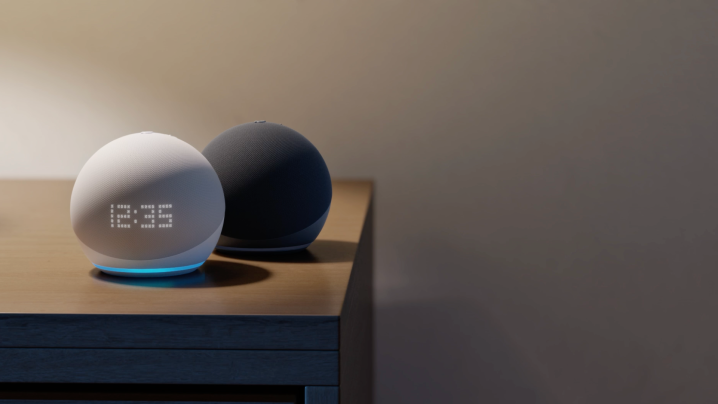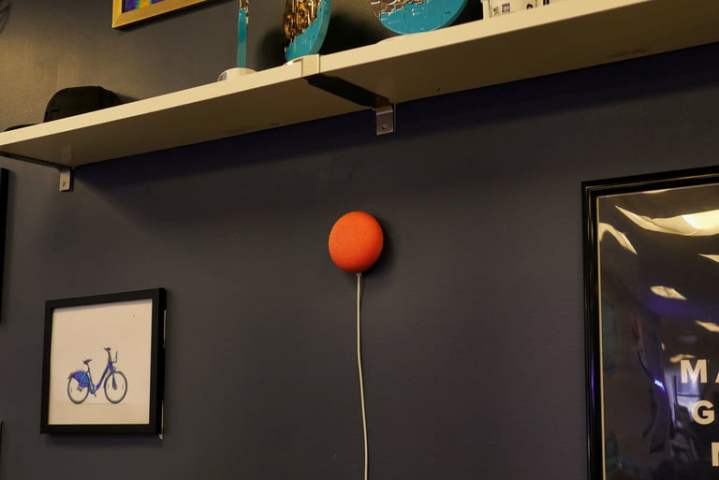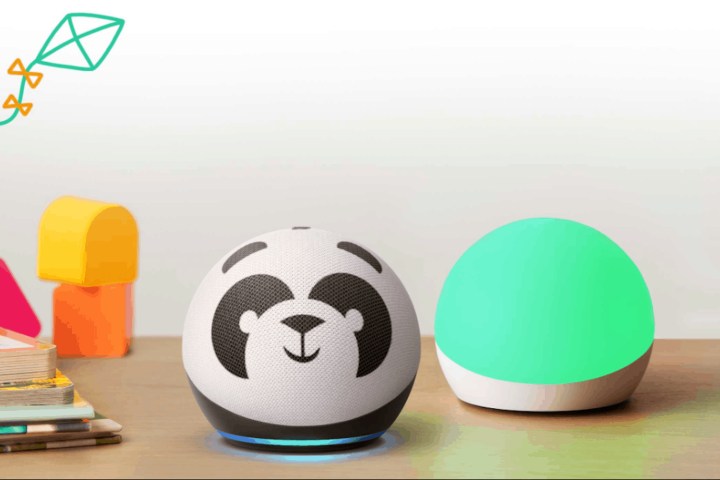Smart speakers come in many sizes, and pitting the Amazon Echo Dot (now on the fifth generation) vs. the Nest Mini (currently on the second version) compares some of the smallest available. These tiny speakers are still loud enough to play music or perform other audio functions for people nearby, and they can make great desktop companions or even smart alarm clocks in some cases.
Which is the best? Despite their diminutive sizes, these little speakers have a lot of differences, starting with their design. Let’s take a look.
Design

The Nest Mini second-gen model has kept its puck-like shape, measuring in at a little less than four inches across and 1.65 inches high. That’s small enough to fit just about anywhere, and it comes in several colors to more easily match surroundings if you want it to. There are a series of LED indicator lights on top and tap controls for volume along with a mic switch, but there’s not much else to this tiny speaker.
The latest Echo Dot, meanwhile, keeps its spherical design closely related to the larger Echo fourth-gen model. At about four inches high and four inches wide, it’s not quite as good at concealing itself as the Nest Mini, but you’ll still be able to put it just about anywhere. There are some basic button controls on top of the speaker, including a mic-off button and an indicator around the base. But the real advantage here is that the extra size of the Dot allows it to offer additional features, notably a version with an LED clock on the side, allowing it to serve as an alarm clock — something the Nest Mini can’t do. There are also kid’s versions with animal covers, which is fun.
Winner: Echo Dot fifth-gen
Speakers and sound

For tiny smart speakers like this, sound is especially important if you plan on using it to listen to music while you work, getting news reports in the morning when you wake up, and so on. Here, the Nest Mini brings a 40mm driver made for 360-degree sound and adds tuning software to improve sound quality based on its background (as well as better bass than the first model).
However, the Mini has never really been able to compete with the Echo Dot on a sound level, and that’s still the case with the last few generations of the Dot, which has really surpassed itself in audio level. The fifth-gen Echo Dot includes improved bass with a 1.73-inch front-firing speaker. It’s quite impressive just how well this speaker can fill a small room or office with sound. There’s no contest here.
Winner: Echo Dot fifth-gen
Portability and placement

With speakers this small, many buyers wonder just how portable they are or what kind of placement options they may offer that differ from larger smart speakers. There’s good and bad news here: Both the Nest Mini and Echo Dot are designed to be connected to an outlet for power. You can’t just pick them up and carry them around like some portable smart speakers. However, there are some important details here.
First, there are battery pack mounts that turn each speaker into a portable version for as long as the battery lasts. It’s generally easier to find these for the Amazon Echo Dot than it is for the Nest Mini, but even Nest’s model has a couple of battery options. These cost more, but it adds portability.
Second, the Nest Mini is designed with mounting slots in the back so it can be easily mounted to a wall, giving you another dimension of placement options. While some wall mounts exist for the Echo Dot, they cost extra and are a much bulkier solution, so it’s not really as practical.
Winner: Nest Mini second-gen
Voice assistants and smart features

The Nest Mini works with Google Assistant and the Google Home app to provide a wide range of app controls and smart home integration options. Anything Google Assistant can do — like answer questions, make calls, or schedule events — the Nest Mini can do with the right voice commands. Via the Google Home app, you can change settings and set a wide variety of routines, like turning on your smart lights and playing a traffic report when you get up in the morning or automatically making sure your door is locked when you get a certain distance from your home. Compatibility with Google Home is vital here but is becoming much less of an issue thanks to the rise of the new Matter protocol.
The Echo Dot does much the same with Alexa, which uses a different app and voice assistant technology but has many of the same capabilities as the Google version. Those features include answering questions, setting schedules, providing notifications (many tied to Amazon services in this case), making calls, and creating routines for the smart home.
But once again, the Echo Dot fifth-gen shows the advantage of newer technology. The latest model includes temperature and movement sensors, so you can choose to link certain smart home functions with how hot or cold it is in the room (like controlling a compatible heater) or if someone has just entered (like turning on a smart light). It can also enable things like Alexa Guard, which listens to alarms or broken glass and, if detected, alerts you when you are away. There’s even some very neat compatibility with Eero Wi-Fi that can turn the Echo Dot into an Eero satellite router to expand your Wi-Fi coverage.
Winner: Echo Dot fifth-gen
Pricing

The Nest Mini second-gen is available for $50 from a variety of sellers. You also can nab the Echo Dot fifth-gen for $50 and choose to bundle it with other devices like a smart plug or Eero router. With similar prices, there’s not a lot to compare here, although we will note that Amazon tends to offer discounts around Prime Days and Black Friday sales.
Winner: Tie
Which mini speaker comes out on top?
The latest technology packed into the Echo Dot fifth-gen is truly impressive, and the second-gen Nest Mini just can’t compare. The only reason to consider the Nest Mini between these two devices is if you really, really don’t like Amazon services or Alexa as a voice assistant.



